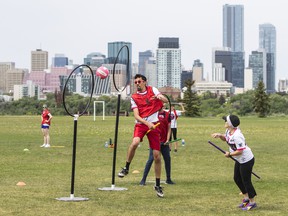The Summer Solsnitch is the biggest fantasy quidditch tournament in Western Canada, happening June 25 at the Edmonton Rugby Football Club.

Reviews and recommendations are unbiased and products are independently selected. Postmedia may earn an affiliate commission from purchases made through links on this page.
Article content
In Quidditch, the snitch is a player who runs around the field with a tennis ball dangling from their waistband, a target for both teams to grab. It’s important to Quidditch; catching the snitch scores 30 points and ends the game.
Advertisement 2
Article content
So it’s no surprise the Aurors, Edmonton’s quidditch team, would honor it while naming the biggest fantasy quidditch tournament in Western Canada, the Summer Solsnitch, happening June 25 at the Edmonton Rugby Football Club. The tournament will draw players from across North America to partake in a sport pulled from the books and movies of the Harry Potter universe.
“Edmonton just really gripped this one. We throw a great Solsnitch,” says Jasper Whitby, vice-president of the Edmonton Aurors who uses them/they pronouns.
Whitby says the tournament is a great place for both new players to learn the game and experienced veterans to come together for midsummer camaraderie. Players register individually and are drafted to teams of seven; they hope to pull about 60 people for this year’s Summer Solsnitch, the same number they had before COVID-19 canceled the games in 2020 and 2021.
advertisement 3
Article content
Quidditch first appeared in the book Harry Potter and the Philosopher’s Stone, released in 1997. Harry and his friends at Hogwarts School of Witchcraft and Wizardry compete by flying around on magic brooms, tossing balls through hoops and chasing down a golden bird.
The game was translated to the pitch in 2005 in New England. It grew slowly through recreational leagues and university teams. McGill University in Montreal would host the first Canadian quidditch team, and it spread throughout the country from there.
“Quidditch is just fun chaos. It’s this mix of handball, but also dodgeball, flag football, there’s a broom between your legs,” says Whitby.
Whitby joined the Edmonton Aurors Quidditch Club in 2018 and is also coach of the club’s recreational team. The club also hosts a competitive team that travels the country and a youth team for players between the ages of eight and 15.
advertisement 4
Article content
The draw for Whitby isn’t the mechanics, the strategy or even the athleticism of the sport.
“Inclusivity is really important to me,” says Whitby. “I play a lot of other sports; soccer, ultimate frisbee, water polo. But they are all very binary gender sports. Quidditch is pretty unique in that it’s not a co-ed sport, it’s a mixed-gender sport.”
On a team of seven, there’s a maximum of four players of one gender at one time. According to Whitby, this helps to create space for trans or gender non-conforming people; the rule applies to their gender identity.
That acceptance may help the sport grow, but Quidditch can be difficult to understand for new players. There’s a lot happening on the field at one time, with up to four balls flying around the pitch.
advertisement 5
Article content
“It’s pretty chaotic, especially if you don’t know what you’re doing. But after a while, you sort of start to see the moving parts, how the different positions work together,” says Milan Cuthbert, a former director with the Aurors and a member of the Edmonton club’s recreation team. “Once you understand the sport a bit more, you can see the plays as they happen and the different movements of the groups compared to seeing chaos of different types of balls flying everywhere.”
Chasers, three from each team, are trying to throw the quaffle, usually a volleyball, through one of three hoops on the other side of the pitch to score points. Another two beaters roam the field tossing bludgers, three foam dodgeballs, at the opposing side to force them to drop what they are doing and run back to their own side of the pitch.
advertisement 6
Article content
confused? Well, there’s also a keeper for each team, and every player has to hold a broomstick between their legs for the entire match. The stick doesn’t do anything and you’re not allowed to remove it from between your legs.
Finally, the snitch is released after 18 minutes, a player dressed in a golden outfit with a tennis ball draped from their waistband. If one team’s seeker can grab the dangling tennis ball, they net their team 30 points and end the game.
While both Whitby and Cuthbert list the acceptance and camaraderie of the sport as a major draw, they are both quick to distance themselves, the club and the sport as a whole from the source material and the author who gave it life.
In the last three years, Rowling has made transphobic comments, comments that she has doubled down on and stood by despite backlash.
“JK Rowling’s transphobia is harmful to the community of Quidditch,” says Cuthbert. “The association of the sport to Harry Potter has also affected the sport’s ability to grow.”
But politics will be put to the side for a long summer’s day at this year’s the Summer Solsnitch where a chance to reconnect with old friends is more important than the score on the board. Except when your team grabs the snitch; that’s a pretty big deal.
For more information about the Edmonton Aurors Quidditch Club and the Summer Solsnitch, visit edmontonquidditch.com.